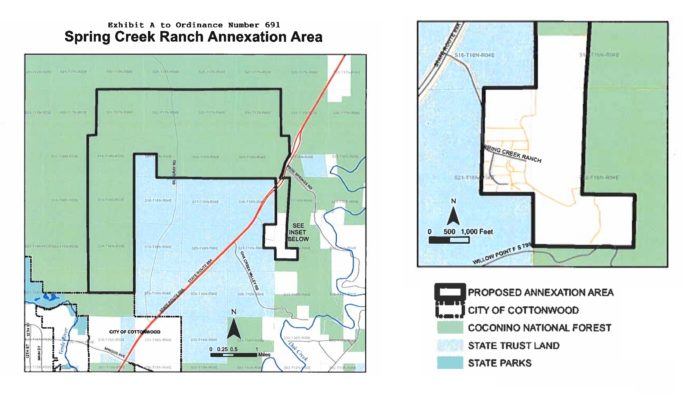By a unanimous vote, the Cottonwood City Council approved the annexation of a proposed planned development off of State Route 89A.
But council stressed that while the annexation of 11 square miles has been approved, the development on 280 acres of that annexed land has a long ways to go before the first shovel may be put in the ground.
“I know many folks are opposed to this and I don’t want to leave you with the impression that we’re not listening to you,” Mayor Tim Elinski said during the Tuesday, Jan. 19, council meeting. “We are absolutely listening to you. I believe this council just doesn’t 100% agree with you or has a different set of circumstances and facts that we’re viewing that will guide our decision-making.
“The point I’m making is, don’t blow your stream on whether or not this is going to be developed. This will be developed but the real battle will begin now. If this is annexed into the city of Cottonwood or remains in [Yavapai] County, the real battle is what this development will look like in the future. We need to quickly get away from opposing any sort of development out there at all and quickly move into what we want that development to look like.”
Like Elinski, others on council said they were in favor of annexation because they feel Cottonwood can better position itself to manage the growth within the annexed land and its resources. Council members also said that what the proposed Spring Creek Ranch looks like on paper today won’t necessarily be what it will look like if approved by council.
The owner of Spring Creek Ranch, Eric Borowsky, and his daughter, Lisa, who is Spring Creek Ranch vice president, first came before Yavapai County more than a year ago seeking a zone change on their 280 acres, which is currently zoned for 140 two-acre parcels. They are seeking to have a planned community with manufactured homes, single- family homes, apartments and an RV park.
In August, they came before the Cottonwood City Council seeking annexation into the city. In September, the Borowskys withdrew their application for a zone change before the Yavapai County Planning and Zoning Commission, with the plan to re-file the application after the first of the year.
At the time of the withdrawal, Lisa Borowsky confirmed that nothing had changed in terms of their desire to be annexed into Cottonwood.
“We are pleased with the decision of the Cottonwood City Council to unanimously approve annexation of Spring Creek Ranch,” she said the day after the Jan. 19 decision. “We look forward to working with the city as we undertake the planning process of our future community. We believe the city is committed to working with us to bring forward a terrific project that will be an asset to the Verde Valley and, most importantly, will address the well documented housing shortage in the area.”
A city report states that the annexation includes a large tract — approximately 11 square miles — of Coconino National Forest land located between the current city boundary and the Spring Creek Ranch parcels, which are not currently contiguous to the city of Cottonwood. The annexation area begins at the city’s north boundary near Dead Horse Ranch State Park and extends north, then east around the north side of State Trust land, to connect and include Spring Creek Ranch property to the south.
As currently proposed, Spring Creek Ranch would include 1,500 lots, with the majority, if not all, being manufactured homes. Additionally, there are plans for 400 apartment units, a maximum of 200 RV spots and a 200-unit assisted living facility, a recreational facility, a small store and one or two restaurants, as well as 58 acres of open space with a 2.5-mile pathway along the creek.
The developer would be responsible for the costs of water, sewer and roads, while the city would provide normal services including police and fire.
The city has received more than 200 public comments on the proposed annexation and potential future development of the Spring Creek Ranch area. A majority of those comments have been in opposition, citing concerns over a variety of issues including expected negative effects on rural lifestyle, traffic, water resources and wildlife.



